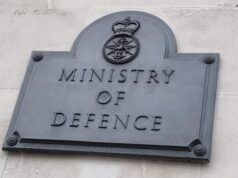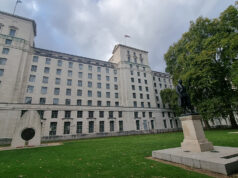At his first on-the-record media briefing as head of Counter Terrorism Policing, Assistant Commissioner Laurence Taylor outlined a sharpened direction for the organisation.
Speaking alongside his deputy Jon Savell to outlets including the UK Defence Journal, he set out a broader understanding of Counter Terrorism Policing’s mission, describing a system that now works to protect the country not only from organised terror but also from state-backed interference, online disinformation, and intimidation of democratic life.
Taylor described three guiding missions that will define his tenure: countering terrorism, confronting hostile state activity, and strengthening protective security around democratic life.
“It’s really important that the counter terrorism policing network is able to focus on its three core missions,” he said, listing “our traditional mission of countering terrorism, our increasing demand of counter state threats, and our third mission of protective security, defending our democracy.”
Taylor comes across as pragmatist shaped by operational policing, and not without reason. He began as a firearms officer, moved through local policing and professional standards, and now sits atop a system that, as he put it, faces “a lot of demand in the system… a lot of activity going on.” His task, as he framed it, is to keep focus amid that pressure.
He was direct about the scale of work under way, telling us, “Since 2020 we’ve stopped 19 late-stage terror plots, what we’d call goal-line saves. We’ve currently got 800 live investigations ongoing, and last year alone, we made 248 terrorism arrests.” That workload, he said, continues to rise. “Counter terrorism threats are increasing. Counter state threats are increasing.”
The second of those missions is expanding fast. “We have seen a five fold increase in the number of investigations that we are managing, and it’s now about 20 percent of our casework,” he said. He named “the big three, Iran, Russia and China” as principal adversaries, adding that CTP has seen “criminal proxies being used by those foreign states.”
Taylor’s appearance before the Home Affairs Committee shortly before the briefing offered a clearer sense of his thinking on the legal and operational gaps now shaping counter extremism. He told MPs that “there is a gap in legislation and everything else to deal with extremism,” leaving law enforcement without powers to intervene in the space between hate crime and terrorism. “Extremism might be part of terrorism, but not all extremism is terrorism,” he said. “That makes it very difficult for law enforcement, because we do not have the powers and levers to deal with that central space.”
He illustrated that gap with examples from online culture. “Through algorithms, content is being pushed to individuals, including online gaming, for example, we have seen sites where the attack in Christchurch is now a game and you can go and commit the 51 murders online. That is not an illegal thing to do.” He also warned that such material builds a mindset among young users, and while most will never act on it, there is no legal framework to step in before harm occurs.
The same session revealed the scale of digital pressure on policing. Taylor said referrals to the Counter Terrorism Internet Referral Unit had risen 150 percent since 2021 and could reach 40,000 a year by 2029. “We saw a 48 percent increase after the attacks on 7 October,” he said, linking spikes in online extremism to global events and disinformation campaigns. He stressed that “we cannot police the internet… it is simply too big and too difficult,” and that new regulation and accountability for tech companies would be essential.
The Home Affairs Committee also drew out his concern about capacity across the Prevent system. He told MPs that referrals have increased by more than a third this year, projecting over 10,000 by year end. “The capability is there, but I do not think the capacity is there,” he said. “The system is not built to deal with this volume of demand.” He argued for a properly funded multi agency triage system, “a big front door,” to direct cases to the right interventions rather than defaulting to Prevent.
Those points echoed through his media briefing days later, he repeated that “we can’t police the internet” and that policing “must focus on the things within our power and pose the greatest threat and risk.”
Deputy Assistant Commissioner Jon Savell spoke about the practical side of preparedness. Martyn’s Law, he said, will start to “hit the road” in around 18 months, with policing ensuring quality in training and content. In the meantime, the emphasis is on the public realm. “You can’t put a ring of steel or ring of concrete around everything,” he said. The aim is “vigilance, unpredictability and engagement.” That includes hostile vehicle mitigation and encouraging workers and the public to approach anyone behaving suspiciously, what he called “the power of hello.”
Savell said the upcoming Martyn’s Law, passed earlier this year, will require venues and event organisers to plan for and mitigate terror risks, with stricter duties for larger sites. The law is due to take effect after a two year implementation period and will be overseen by the Security Industry Authority, which will guide and enforce compliance.
Asked about rail security after the Huntingdon attack, Taylor urged calm assessment rather than quick fixes. “It needs to be properly thought through, not knee jerking into a response,” he said. Savell added that public vigilance and staff readiness remain the strongest defences.
Between Parliament and the press, Taylor’s message has been consistent. He is pushing for sharper focus within counter terror policing, clearer legal tools for extremism that falls short of terrorism, and a wider system able to absorb growing demand.
“This requires co ordinated action across government, stronger regulation, accountability for online platforms and closing that legal gap that exists for extremism,” he told MPs. His tone was pragmatic rather than alarmist, but his warning was clear. “The threats are increasing, and the system is not yet built to meet them.”
Flying back to Glasgow via Luton after the briefing, I noticed a heavier police presence around the airport. I was stopped briefly at one of the small pedestal sized booths beyond security and asked a few routine questions. Under Schedule 7 of the Terrorism Act, officers can question travellers at ports and airports to identify potential risks before they enter or leave the country. It was a small, practical example of the kind of preventive work discussed throughout the briefing.













An important side to the defence of the UK that is often overlooked by many with the focus on military size and capabilities.
Good to see confirmation that counter state threat effort, so assume that includes counter espionage, is increasing.
Counter Terrorist Command, by my understanding, absorbed the traditional Special Branches of the regional police forces that once had the Counter Espionage role, in conjunction with the Security Service.
For background interest, there are 5 CTUs and several more smaller CTIUs around the country. They work with the regional network of the Security Service to counter local threats, these sites were developed after 2005 when MI5 found itself too London centric.
They are overseen by the national CTOC which is now in a building in West London.
Various reports from the Parliamentary ISC found that the Security Service was so CT centered that the CE and PS side had too few assets allocated, with Russian and Chinese
espionage rising yearly.
Encouraging to read.
This is interesting considering what went on with Sheffield Hallam University where China essentially attacked that university via both intimidation and law war to get it stop perfectly valid research.. it used both intimidation and threat as well as using a commercial company to attack the university legally and get it stripped of insurance to carry on research.. this is a lesson in the fact China is a communist state and every Chinese owned and registered Business in China is an arm of that state.. no matter its “legal “ owners.